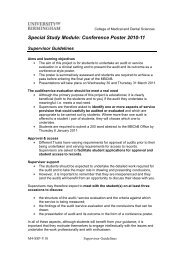Contents - College of Medical and Dental Sciences - University of ...
Contents - College of Medical and Dental Sciences - University of ...
Contents - College of Medical and Dental Sciences - University of ...
Create successful ePaper yourself
Turn your PDF publications into a flip-book with our unique Google optimized e-Paper software.
The 11 th International Workshop on KSHV & Related Agents, Birmingham, UK<br />
Virus-Cell Interactions II Abstract 61<br />
MURINE GAMMAHERPESVIRUS 68 ESTABLISHES A PERSISTENT INFECTION IN<br />
ENDOTHELIAL CELLS<br />
A.L. Suárez <strong>and</strong> L.F. van Dyk<br />
<strong>University</strong> <strong>of</strong> Colorado Denver School <strong>of</strong> Medicine, Department <strong>of</strong> Microbiology, 12800 E<br />
19 th Ave, RC1 North Bldg P18-9401A, Aurora, CO 80010, USA<br />
Abstract<br />
Gammaherpesvirus associated diseases occur predominately in immunocompromised<br />
individuals. Gammaherpesvirus infection <strong>of</strong> cells usually results either in productive lytic<br />
infection, characterized by expression <strong>of</strong> all viral genes <strong>and</strong> complete cell lysis, or in<br />
latent infection, in which few viral genes are expressed <strong>and</strong> no cell lysis occurs.<br />
Herpesvirus infections must traverse endothelial cell (EC) barriers, <strong>and</strong> infection <strong>of</strong> ECs is<br />
important to the pathogenesis <strong>of</strong> both human cytomegalovirus <strong>and</strong> Kaposi’ sarcoma<br />
associated virus. The role <strong>of</strong> ECs in the mouse model system, gammaherpesvirus 68<br />
(gHV68), has not been previously characterized. Recently, we demonstrated that ECs<br />
were unique in that a significant proportion <strong>of</strong> the cells escaped lysis, remained viable<br />
<strong>and</strong> proliferated in culture, but continued to produce infectious virus. Infected ECs were<br />
altered in adherence, morphology <strong>and</strong> surface marker expression. However, infected ECs<br />
maintained MHC class I expression, suggesting that EC contribution to pathogenesis is<br />
likely limited to immunodeficient states. Primary ECs also supported productive infection<br />
with enhanced survival, <strong>and</strong> we are now investigating ECs as a source <strong>of</strong> persistent<br />
infection in vivo. From a panel <strong>of</strong> gHV68 mutants, we identified several viral oncogenes<br />
which promote survival <strong>of</strong> infected ECs. Intriguingly, the viral genes which promote EC<br />
survival have previously been characterized as important in latency, but dispensable for<br />
lytic infection. Our data reveal a cell type specific outcome <strong>of</strong> gHV68 infection which can<br />
provide an ongoing source <strong>of</strong> virus production. gHV68 infection <strong>of</strong> ECs provides a facile<br />
screen for viral persistence genes <strong>and</strong> investigation <strong>of</strong> EC infection in pathogenesis.<br />
Presenting author Email: <strong>and</strong>rea.suarez@uchsc.edu<br />
89















